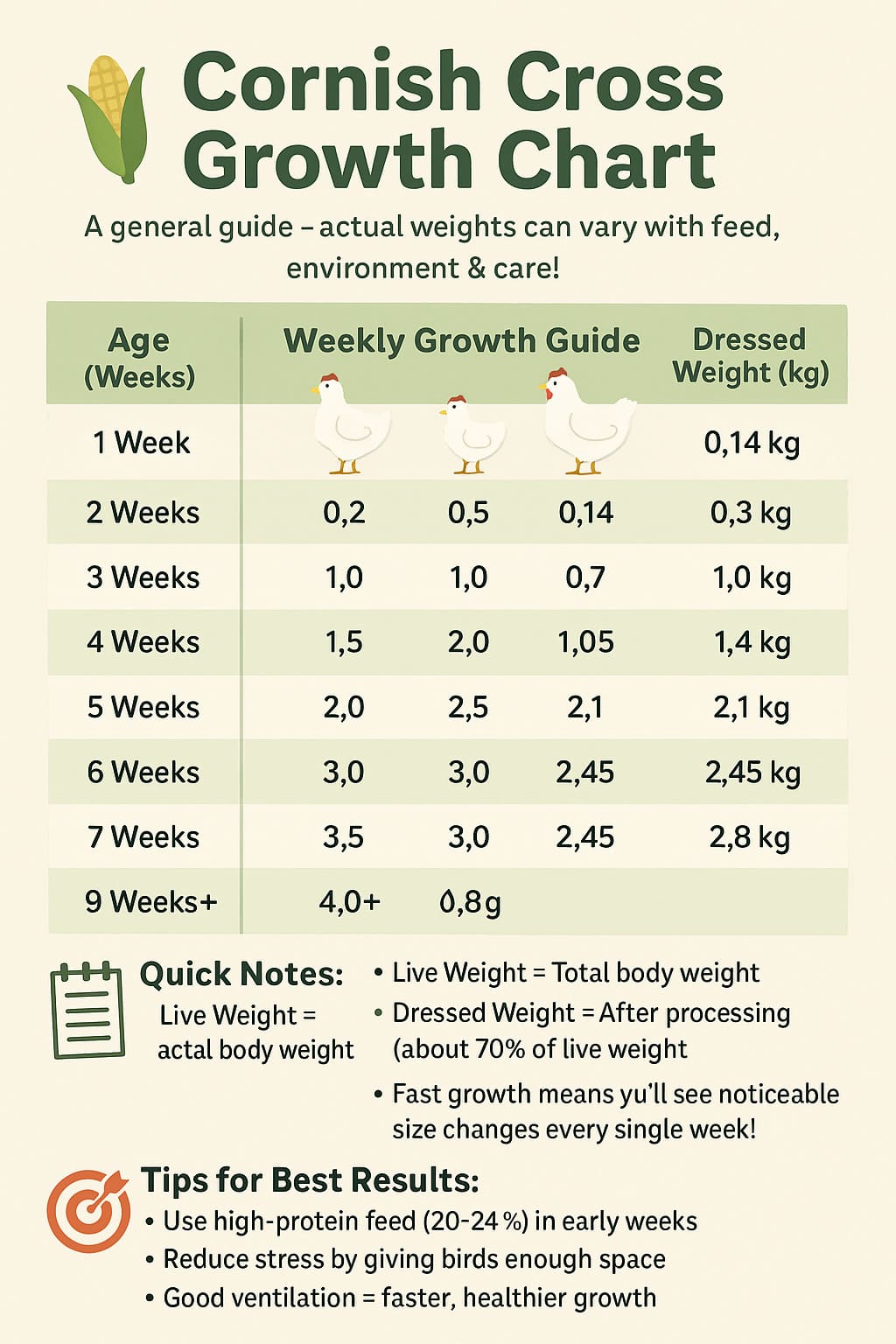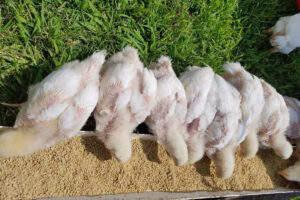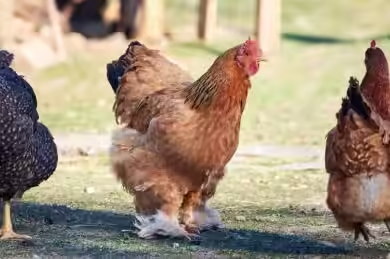Last updated on August 15, 2025
To successfully raise a Cornish Cross, you need to know one key fact: they’ll eat about 8.5 kg of feed to reach a butchering weight of 3.5 kg in just 8 weeks. This guide is your comprehensive resource for understanding their needs, from their critical feeding schedule to their typical lifespan and butcher dates. For those planning a large flock, you can use our broiler feeding guide to help with your bulk feed needs.
What are the Disadvantages of the Cornish Cross?
While the Cornish Cross is an agricultural marvel, it’s important to address its specific disadvantages head-on. Their genetics are engineered for a single purpose: rapid growth for meat production. In my experience, this specialization comes at a cost, making them a poor choice for birds you intend to keep for a long time.
As noted in a 2017 academic thesis from the University of Manitoba, while the Cornish Cross is not ideal for foraging, its “extremely fast growth rate compared to the other varieties makes them the most economical option.” This highlights the crucial trade-off inherent in the breed.
- Rapid Growth and Health Issues: The sheer speed at which they grow can outpace their skeletal development. This often leads to leg problems, lameness, and foot issues if their environment isn’t ideal. A 2024 review in Poultry Science noted that while slow-growing breeds are better suited for certain systems, the welfare outcomes of conventional broilers are a key area of concern, with health issues like “footpad dermatitis, mortality, and lameness” being common risks.
- Heart and Respiratory Problems: Their large body mass puts a significant strain on their heart and respiratory systems, making them susceptible to conditions like “flip-over disease,” which can lead to sudden death.
- Low Survivability: The Cornish Cross is not bred for longevity. Their fast-growing nature means they are typically only viable for their specific grow-out period. Keeping them past the 8-10 week mark drastically increases the risk of health complications. As noted in The Homestead Poultry Flock by a long-time poultry writer, “Such souped-up hybrids… are less hardy and long-lived than traditional breeds, and are apt to succumb to disease or environmental stresses more readily.”
A Note on Keeping Cornish Cross for Eggs
Many Nigerian farmers I’ve spoken with are curious about keeping these birds for eggs. I always have to explain that the Cornish Cross is not bred for egg production. Their rapid weight gain and large body size make them incredibly inefficient egg layers, and they are prone to significant health problems if kept past their optimal grow-out period. If you’re looking for a dual-purpose or egg-laying breed, it’s really best to consider other options.
Common Mistakes When Raising Cornish Cross
Avoiding these common errors can significantly improve your flock’s health and your overall yield. For a deeper look into health issues and mortality, you can find more information here: Why are my Cornish Cross chicks dying?
- Not Restricting Feed: After the initial chick phase, free-feeding can be the single biggest mistake you make. The birds will eat themselves to death, leading to a much higher risk of “flip-over disease” and leg problems. This is because their bodies grow too quickly for their heart and skeletal system to keep up. Solution: From week 3 onward, get into a strict feeding schedule. An overnight feed restriction of 12 hours is a non-negotiable step to give their bodies a much-needed break.
- Poor Ventilation: Especially in hot climates like Nigeria, poor airflow can cause heat stress, which is a major killer of Cornish Cross. Their dense bodies and fast metabolism make them highly susceptible. In addition, poor ventilation allows a build-up of ammonia from their droppings, which can cause respiratory issues. Solution: Ensure your poultry house has excellent cross-ventilation. During the hottest parts of the day, consider using fans, or even a simple sprinkler system on the roof, to help keep the birds cool.
- Using the Wrong Feed Type: Giving a high-protein starter feed for too long is not only expensive but can also put undue stress on the birds’ kidneys and digestive systems. Conversely, transitioning to a finisher feed too early won’t provide the necessary protein for muscle development. Solution: Follow a structured feeding plan exactly as outlined in the chart below. Move from a starter to a grower, and then to a finisher feed at the appropriate weeks to support healthy, balanced growth.
- Overcrowding: A crowded pen is a recipe for disaster. It leads to increased stress, aggressive behavior, and a rapid spread of diseases. It also makes it difficult for all birds to get adequate access to food and water. Solution: Provide enough space for your birds to move freely and comfortably. A good rule of thumb is to aim for at least
2-3 square feetof space per bird by the time they are ready for harvest. - Not Deworming at the Right Time: While internal parasites may not seem like a big issue, they can significantly impact a broiler’s growth and health. A proactive deworming schedule is a simple way to protect your investment. You can learn the best timing in our complete guide on deworming.
Your Weekly Health & Management Checklist
This proactive checklist helps you stay on top of the most critical management tasks and health risks for each stage of your Cornish Cross flock’s growth. As a 2009 review of organic poultry welfare concluded, “maintaining good health and welfare… can be challenging… suggesting that husbandry (knowledge and technical skills) is crucial in managing welfare issues.”
| Age (Weeks) | Key Management Task | Health Risk to Watch For |
|---|---|---|
| 0-2 | Check brooder temperature daily. Ensure bedding is dry and non-slip. | Pasty Butt: Caused by chilling. Action: Gently clean with a warm cloth. Check for drafts. |
| 3-5 | Begin 12-hour feed restriction. Monitor for leg stress. | Leg Weakness/Splayed Leg: From growing too fast. Action: Ensure feed restriction is strict. Do not let feeders run empty during the day. |
| 6-9 | Maximize ventilation. Ensure constant access to cool, clean water. | Heat Stress & Heart Failure (Flip-Over): From large body size and heat. Action: Use fans, ensure shade, and consider adding electrolytes or even a homemade booster to water on very hot days. |
Cornish Cross Feeding Chart (By Week/Age)
Following a structured feeding plan is the most important factor in raising a healthy and successful flock of Cornish Cross chickens. This chart, which is based on recommendations from agricultural extension services and local experts, breaks down the typical phases and protein requirements for their rapid growth.
| Age (Weeks) | Feed Type | Protein % | Notes |
|---|---|---|---|
| 0 – 2 weeks | Broiler Chick Starter | 22-24% | Provide this feed ad libitum (all they can eat) to give them a strong start. |
| 3 – 5 weeks | Broiler Grower | 20-22% | Transition to a grower feed. This supports muscle and bone development while maintaining growth. |
| 6 – 9 weeks | Broiler Finisher | 18-20% | This feed has lower protein and helps them put on weight and fat for a better carcass. |
How Long Do You Feed Cornish Cross Chick Starter?
You should feed Cornish Cross chicks a high-protein starter feed for their first 2-3 weeks to ensure they develop a strong muscle and bone structure from the very beginning. In Nigeria, popular brands include Topfeeds, Vital Feeds, and Grand Cereals. Keep in mind that feed prices and availability can fluctuate, so it’s always wise to check with your local feed supplier.
How Much to Feed Cornish Cross Per Day?
During the first few weeks, it’s common to allow unlimited access to feed. As they mature, though, you’ll want to monitor their intake to prevent health issues.
- Week 1-2: Ad libitum (unlimited access)
- Week 3-4: Roughly 120 – 150 grams per day
- Week 5-6: Roughly 160 – 190 grams per day
- Week 7-9: Roughly 200 – 220 grams per day
Can You Overfeed Cornish Cross?
Yes, you absolutely can. After the first few weeks of unlimited access, a common and highly recommended practice is to restrict feed for 12 hours overnight. This prevents them from eating excessively and gives their bodies a chance to rest and process the feed. Restricting feed helps prevent sudden death from heart failure (flip-over disease) and encourages their legs and skeletal system to catch up with their rapid weight gain.
A Farmer’s Unique Tip: The Power of a Mid-Day Break
Building on the concept of feed restriction, one of the most effective techniques I’ve learned is to give the birds a short, two-hour feed break in the middle of the day in addition to the overnight restriction. For example, if you feed them from sunrise to sundown, you can remove the feeders for a couple of hours around noon. This simple practice encourages them to get up, move around, and drink more water. It keeps them from just sitting by the feeder all day, which improves their overall health and skeletal strength, and ultimately leads to a healthier, better-quality bird.
Choosing the right equipment is also key to preventing waste and promoting hygiene. For a detailed look at feeder and waterer options, see our guide on poultry farming equipment for broilers.
Cornish Cross Growth and Butchering Schedule
The entire purpose of raising a Cornish Cross is to get them to their processing weight quickly and efficiently.
How Long Does It Take to Raise a Cornish Cross Chicken?
The typical grow-out period is between 6 and 9 weeks.
At What Age Do You Butcher Cornish Cross Chickens?
- 6 weeks: This is a good time to butcher for smaller “fryer” chickens, which are tender and perfect for single meals. They will typically weigh around 2−2.5 kg live weight.
- 8-9 weeks: This is the ideal time for larger “roaster” chickens. At this age, they can reach a live weight of 3.5−5.0 kg, providing a substantial amount of meat.

Cornish Cross Growth Chart
This is a general guide, and actual weights may vary depending on feed quality, environment, and management practices.
| Age (Weeks) | Expected Live Weight | Expected Dressed Weight |
|---|---|---|
| 1 week | 0.2 kg | 0.14 kg |
| 2 weeks | 0.5 kg | 0.35 kg |
| 3 weeks | 1.0 kg | 0.7 kg |
| 4 weeks | 1.5 kg | 1.05 kg |
| 5 weeks | 2.0 kg | 1.4 kg |
| 6 weeks | 2.5 kg | 1.75 kg |
| 7 weeks | 3.0 kg | 2.1 kg |
| 8 weeks | 3.5 kg | 2.45 kg |
| 9 weeks | 4.0 kg+ | 2.8 kg+ |
How Much Feed Does a Cornish Cross Eat in 8 Weeks?
A single Cornish Cross will eat approximately 8.5 kg of feed to reach a live weight of 3.5 kg in 8 weeks. This is a crucial number for budget planning and ensuring you have enough feed on hand for your flock.
Cornish Cross Feed Calculator
Planning your budget and feed supply is one of the most critical steps. To help, you can use our upcoming calculator to determine how much feed you’ll need for your entire flock.
The Formula: (Number of Birds) x 8.5 kg = Total Feed Needed for 8 Weeks
Example Calculation for a Flock of 25 Birds: 25 Birds x 8.5 kg/bird = 212.5 kg of feed
Since most commercial feed in Nigeria is sold in 25 kg bags, you can figure out how many bags to buy: 212.5 kg / 25 kg/bag = 8.5 bags
Therefore, you should plan to purchase 9 full bags of feed to raise 25 Cornish Cross chickens to 8 weeks of age.
Is a Small Batch Profitable? A Sample Worksheet
Many farmers start with a small batch of 25 birds to test the waters. Here’s a sample worksheet to estimate your potential profit. Fill in the blanks with prices from your local suppliers in Nigeria.
Expenses:
- Cost of 25 Day-Old Chicks: (25 x ₦__) = ₦____
- Cost of Feed (9 bags): (9 x ₦__) = ₦____
- Cost of essential vaccines and medications to prevent common illnesses: = ₦______
- Cost of Bedding/Labor/Other: = ₦______
- Total Estimated Cost: = ₦______
Potential Revenue:
- Expected Live Weight per Bird: 3.5 kg
- Current Market Price per kg (Live Weight): ₦______
- Total Sale Price per Bird: (3.5 x ₦__) = ₦____
- Total Estimated Revenue (25 birds): = ₦______
Estimated Profit: (Total Revenue – Total Cost) = ₦______
Get Your Free Printable Chart
For easy reference in your coop or at the feed store, download our free, one-page Cornish Cross Feeding & Growth Chart PDF. It’s a simple, helpful tool to keep your feeding schedule and growth goals in mind throughout the entire process.
[Download the Charts as a PDF]
What is the Lifespan of a Cornish Cross Chicken?
The lifespan of a Cornish Cross is, by design, its grow-out period. They are not a bird you would keep for egg production or as a pet. Their highly specialized genetics make it difficult for them to live past 10 weeks without significant health issues. Successfully raising a Cornish Cross means processing them at their optimal weight and age.
FAQs on Cornish Cross Feeding Chart
What is a Cornish Cross chicken?
A Cornish Cross is a hybrid chicken breed specifically developed for rapid meat production.
How much space do Cornish Cross chickens need?
A good rule of thumb is to provide a minimum of 2-3 square feet of space per bird by the time they are ready for harvest to prevent overcrowding and stress.
Can I raise Cornish Cross for eggs?
No, they are not bred for egg production and will likely face severe health problems if kept past their typical grow-out period of 8-10 weeks.
How long does it take to raise a Cornish Cross?
The average grow-out period is between 6 and 9 weeks, depending on the desired size for butchering.
Why is feed restriction important for them?
Restricting their feed for 12 hours overnight helps prevent sudden death from heart failure and allows their skeletal systems to catch up with their rapid growth.
Conclusion
Raising Cornish Cross chickens is a rewarding endeavor when you have the right plan. By following a structured feeding chart, being mindful of their health, and adhering to an appropriate butchering schedule, you can efficiently and humanely raise a flock that provides a plentiful supply of meat. A little planning goes a long way with these specialized birds. For further advice or information, consider reaching out to your local agricultural extension office or a trusted organization like the Poultry Association of Nigeria (PAN).
What is the biggest challenge you’ve faced while raising Cornish Cross? Share your experience in the comments below!


